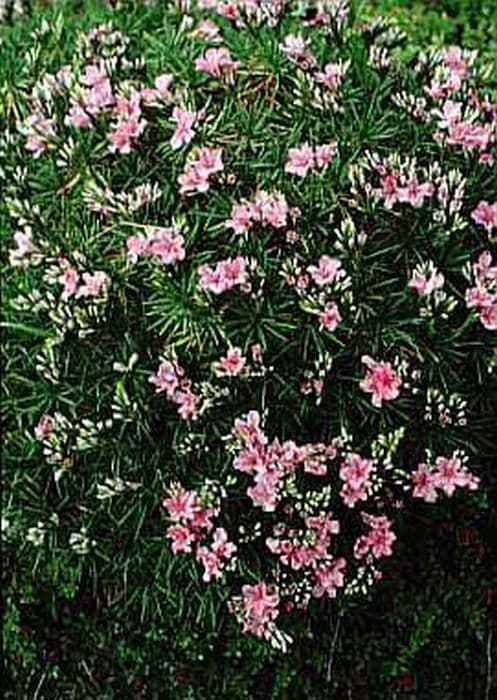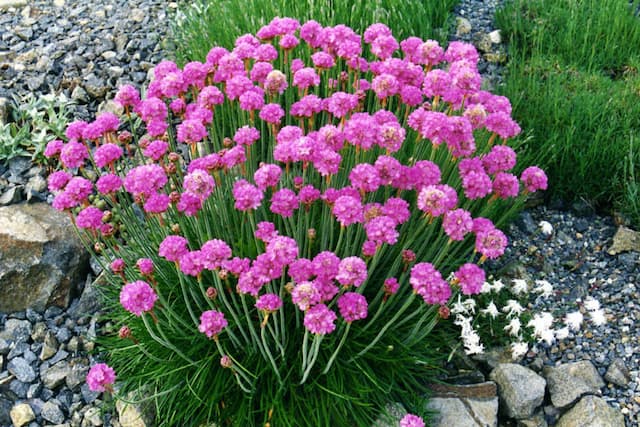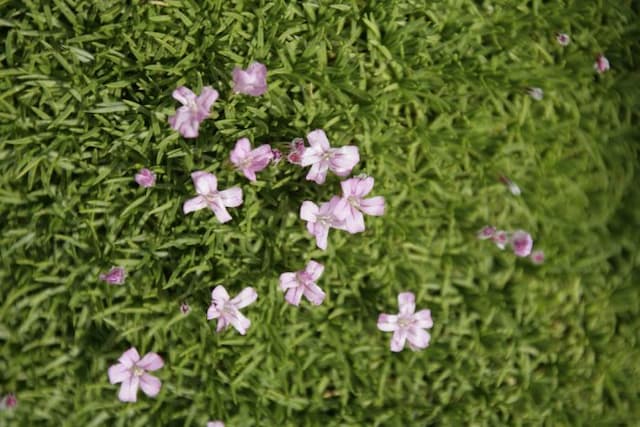Juniper-leaved Thrift Armeria juniperifolia

ABOUT
Armeria juniperifolia, commonly known as the juniper-leaved thrift, is a perennial plant notable for its dense tufts of needle-like foliage that give it an appearance reminiscent of a juniper shrub. This evergreen plant boasts a cushion-like form composed of numerous, tightly packed, dark green leaves which are fine and pointed, creating a texture similar to that of fine grass or moss. From late spring to early summer, the juniper-leaved thrift produces rounded flower heads that rise above the foliage on slender, erect stems. These blossoms are typically a vibrant pink color that adds a striking contrast to the green undergrowth. The flowers cluster tightly together in globular formations, resembling small pom-poms dotting the top of the plant. The blooming season brings a flush of color and can attract a variety of pollinators such as bees and butterflies to the garden. As a tough and hardy plant, the juniper-leaved thrift adapts well to various conditions and is often used in rock gardens, edgings, and borders, where its unique foliage texture and cheerful flowers can be showcased. Despite its robust nature, the plant maintains a compact and orderly presence in the landscape, seldom becoming unruly or overly expansive. This disciplined growth habit, along with its distinctive needle-like leaves, easily distinguishes it from other species in garden settings.
About this plant
 Names
NamesFamily
Plumbaginaceae
Synonyms
Juniper-Leaved Sea Thrift, Juniper-Leaved Thrift
Common names
Armeria juniperifolia is the basic scientific name provided, and no synonyms are found for this plant.
 Toxicity
ToxicityTo humans
Armeria juniperifolia, commonly known as Spanish thrift, is not widely recognized as a poisonous plant to humans. There is limited information on its toxicity, and it is generally not considered a threat. Consequently, there are no well-documented symptoms of poisoning from ingesting parts of this plant. Nevertheless, as with any plant, individual allergic reactions or sensitivities can occur, so it is wise to exercise caution and not consume any plant parts unless they are known to be safe.
To pets
Spanish thrift (Armeria juniperifolia) is also not widely recognized as a poisonous plant to pets. There is a scarcity of information concerning its toxicity, and it is not typically listed as a plant that is harmful to pets such as dogs or cats. Therefore, ingestion of this plant is not expected to cause significant symptoms of poisoning in pets. However, pet owners should always monitor their animals for any signs of distress after ingesting plant material, as individual animals might have unique sensitivities.
 Characteristics
CharacteristicsLife cycle
Perennials
Foliage type
Evergreen
Color of leaves
Green
Flower color
Pink
Height
0.5 feet (15 cm)
Spread
1 feet (30 cm)
Plant type
Herb
Hardiness zones
4
Native area
Mediterranean
Benefits
 General Benefits
General Benefits- Decorative Appeal - Armeria juniperifolia, commonly known as Thrift, has attractive, compact foliage and dense clusters of pink to purple flowers, making it a popular choice for ornamental gardens.
- Drought Resistance - Thrift is highly tolerant of dry conditions once established, requiring minimal watering and suitable for xeriscaping.
- Low Maintenance - It requires little maintenance beyond the occasional deadheading of spent flowers to promote further blooming.
- Erosion Control - The dense, mat-forming habit of Thrift helps stabilize soil and prevent erosion on slopes and in coastal areas.
- Tolerates Poor Soils - Thrift can thrive in poor, rocky soils where other plants might struggle, making it useful for challenging sites.
- Attracts Pollinators - The flowers of Thrift attract bees and butterflies, contributing to the local ecosystem by supporting pollinators.
- Seasonal Interest - With a long blooming season from late spring to summer, Thrift provides extended visual interest in the garden.
- Ground Cover - Its growth habit makes it an excellent ground cover option, filling in spaces and suppressing weeds.
- Rock Gardens - Thrift is ideal for rock gardens, providing texture and color contrast amongst rocks and gravel.
- Seaside Gardens - Being native to coastal areas, Thrift is salt tolerant and can thrive in seaside garden conditions.
- Border Edging - The tidy, compact nature of Thrift makes it perfect for creating defined edges along garden borders or pathways.
 Medical Properties
Medical PropertiesThis plant is not used for medical purposes.
 Air-purifying Qualities
Air-purifying QualitiesThis plant is not specifically known for air purifying qualities.
 Other Uses
Other Uses- Thrifty Sea Pink can be used in rock gardens due to its compact growth habit and ability to thrive in poor, rocky soils.
- Because of its salt tolerance, Thrifty Sea Pink is an excellent choice for coastal landscaping, offering erosion control on seaside slopes.
- The plant can be utilized in green roofing systems where its drought tolerance makes it a sustainable vegetation option.
- Its ability to form a dense mat makes Thrifty Sea Pink suitable for use as a ground cover, preventing weed growth and covering bare spots.
- This plant can be incorporated into fairy gardens for its fine-textured foliage, which complements miniature settings.
- Thrifty Sea Pink is suitable for xeriscaping, helping to reduce the need for irrigation in dry climate gardens.
- The cushion-like form and vibrant flowers allow it to be a visually appealing edge plant in garden borders.
- In floral arrangements, the dried flowers of Thrifty Sea Pink can add unique texture and a natural touch to bouquets and indoor displays.
- It's used in butterfly gardens to attract pollinators, as its flowers are a nectar source for butterflies and bees.
- Thrifty Sea Pink can provide winter interest in the garden with its evergreen foliage, maintaining structure and color in colder months.
Interesting Facts
 Feng Shui
Feng ShuiThe Armeria maritima, commonly known as Sea Thrift or Thrift, is not used in Feng Shui practice.
 Zodiac Sign Compitability
Zodiac Sign CompitabilityThe Armeria maritima, commonly known as Sea Thrift or Thrift, is not used in astrology practice.
 Plant Symbolism
Plant Symbolism- Endurance: Armeria juniperifolia, commonly known as Thrift or Sea Pink, often grows in tough, coastal conditions, enduring strong winds and salty sprays, symbolizing the ability to withstand challenging situations.
- Survival: Its ability to survive with minimal soil and nutrients in rocky crevices signifies resilience and the capacity to thrive against the odds.
- Conservation: Thrift is sometimes used in xeriscaping, representing the conservation of resources, particularly water.
- Frugality: The common name "Thrift" reflects economic and resource frugality, as the plant needs little care and grows in poor soils, showcasing the value of simplicity and minimalism.
- Beauty and Adornment: With its attractive pink blossoms, Thrift is emblematic of natural beauty and is often used to beautify coastal areas and gardens, symbolizing the adornment of one's surroundings regardless of harsh conditions.
 Water
WaterFor sea thrift, which is the most common common name for Armeria juniperifolia, it’s important to establish a consistent watering routine, especially during its first growing season to ensure a deep and extensive root system. Once established, sea thrift is quite drought-tolerant. Water the plant deeply but infrequently, aiming for about 1 inch of water per week, whether from rainfall or irrigation. During hot or dry weather, check the soil moisture and water only if the top two inches of soil are dry to the touch. Be careful not to overwater, as sea thrift does not like soggy conditions. It is preferable to use a soaker hose or drip irrigation to apply water directly to the soil, minimizing moisture on the foliage.
 Light
LightSea thrift thrives best in full sun to partially shaded environments. The ideal spot for this plant is a location where it will receive at least 6 hours of direct sunlight per day. Being adaptable to a range of light conditions, it can also do well in slightly shaded areas, but the blooms may not be as prolific. Avoid deep shade, as insufficient light can lead to poor growth and fewer flowers.
 Temperature
TemperatureSea thrift is hardy and can tolerate a wide range of temperatures. This plant can survive minimum temperatures down to about 10 degrees Fahrenheit, making it suitable for many temperate climates. The ideal temperature range for thriving sea thrift plants is between 60 and 75 degrees Fahrenheit, although they can withstand higher temperatures as long as they are not excessive.
 Pruning
PruningPruning sea thrift is primarily done to remove spent flower stems and to maintain the plant’s compact shape. After the first flush of bloom, trim back the flower stalks to encourage a second bloom. The best time for a more thorough pruning is in the early spring or late fall; removing old foliage can invigorate the plant and promote denser growth. It is not usually necessary to prune sea thrift more than once or twice a year.
 Cleaning
CleaningAs needed
 Soil
SoilThrift (Armeria juniperifolia) prefers well-draining soil with a mixture of sand, loam, and peat to simulate its natural coastal habitat. Aim for a soil pH between 5.5 and 7.5 for optimal growth.
 Repotting
RepottingThrift (Armeria juniperifolia) typically does not need frequent repotting and can be repotted every 2-3 years or when it outgrows its current container.
 Humidity & Misting
Humidity & MistingThrift (Armeria juniperifolia) tolerates a wide range of humidity levels and does not require high humidity; average room humidity is generally sufficient.
 Suitable locations
Suitable locationsIndoor
Place Thrift near a sunny window and ensure good airflow.
Outdoor
Plant Thrift in full sun with well-drained soil.
Hardiness zone
4-8 USDA
 Life cycle
Life cycleArmeria juniperifolia, commonly known as Juniper-leaved thrift, begins its life as a seed, which germinates in favorable conditions with well-draining soil and full sun exposure. The seedling emerges and develops into a compact, evergreen perennial with needle-like foliage, characteristic of its juniper-like appearance. The plant then enters a vegetative stage, where it forms tufted mounds and continues to grow and mature. Once mature, in late spring to early summer, it blooms, producing globular pink to violet flower clusters atop long stems that rise above the foliage. After pollination, typically by insects, the flowers develop into small seed capsules containing numerous seeds, which are then dispersed by wind or animal activity. In favorable conditions, the cycle continues as these seeds germinate and grow into new Armeria juniperifolia plants, while the original plant can persist for many years, given its perennial nature.
 Propogation
PropogationPropogation time
Spring
The Armeria juniperifolia, commonly known as the Juniper-leaved Sea Thrift, is a perennial that can be propagated through seed or division. However, the most popular method is through division, which is best done in the spring or early autumn. To propagate by division, the clumps of the plant should be carefully lifted from the ground and gently separated into smaller clumps, ensuring that each division has a portion of the root system intact. These divisions can then be immediately replanted into well-draining soil at the same depth they were originally growing, and watered thoroughly. The newly planted divisions should be kept moist until they are established and showing signs of new growth.









